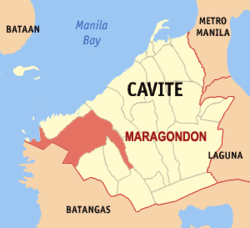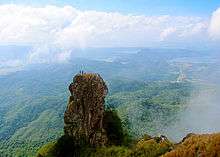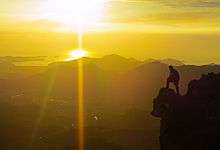Maragondon, Cavite
| Maragondon | ||
|---|---|---|
| Municipality | ||
|
Town plaza | ||
| ||
| Nickname(s): Historic Town & a Wildlife Sanctuary | ||
 Map of Cavite showing the location of Maragondon | ||
.svg.png) Maragondon Location within the Philippines | ||
| Coordinates: 14°16′24″N 120°44′18″E / 14.27333°N 120.73833°ECoordinates: 14°16′24″N 120°44′18″E / 14.27333°N 120.73833°E | ||
| Country | Philippines | |
| Region | CALABARZON (Region IV-A) | |
| Province | Cavite | |
| District | 7th District of Cavite | |
| Founded | 1727 | |
| Barangays | 27 | |
| Government[1] | ||
| • Mayor | Reynaldo Rillo | |
| • Vice Mayor | Ireneo C. Angeles | |
| Area[2] | ||
| • Total | 164.61 km2 (63.56 sq mi) | |
| Population (2015)[3] | ||
| • Total | 37,720 | |
| • Density | 230/km2 (590/sq mi) | |
| Time zone | PST (UTC+8) | |
| ZIP code | 4112 | |
| Dialing code | +63 (0)46 | |
| Income class | 3rd class | |
The Municipality of Maragondon (Filipino: Bayan ng Maragondon) is a third class municipality in the province of Cavite, Philippines. Maragondon is 54 kilometres (34 mi) south-west from Manila. According to the 2015 census, it has a population of 37,720 people.[3]
The name of the town is often confused by immigrants and visitors from Cebu, mistakenly calling it as Marigondon, which is a barangay in Lapu-Lapu City.
Barangays
Maragondon is politically subdivided into 27 barangays.[2]
- Bucal 1
- Bucal 2
- Bucal 3A
- Bucal 3B
- Bucal 4A
- Bucal 4B
- Caingin Pob.
- Garita 1A
- Garita 1B
- Layong Mabilog
- Mabato
- Pantihan 1 (Balayungan)
- Pantihan 2
- Pantihan 3 (Pook na Munti)
- Pantihan 4 (Pulo ni Sara)
- Sta. Mercedes (Patungan)
- Pinagsanhan A (Ibayo)
- Pinagsanhan B (Ibayo)
- Poblacion 1A
- Poblacion 1B
- Poblacion 2A
- Poblacion 2B
- San Miguel A (Caputatan)
- San Miguel B (Caputatan)
- Talipusngo
- Tulay Silangan (Mabacao)
- Tulay Kanluran (Mabacao)
History
The name Maragondon was derived from Tagalog word madagundong or maugong, meaning much sound. Actually the sounds comes from a noisy river called Kay Albaran in the barrio of Capantayan. This area was the first townsite selected, but because the river frequently overflowed and flooded the place, the town was later relocated to its present site. The word madagundong not being pleasant to the ear, the people had it changed to marigundong in honor of the town' s patron saint, Nuestra Senora Maria Asuncion (Our Lady of The Assumption).
Soon after the establishment of the American regime, Lope K. Santos, an authority on Tagalog language and member of a geographic committee created to "investigate and revise" the names of Philippine towns and provinces, recommended the change of Marigundong to "Maragondon" definitely more pleasing to the ear, the present name of the town
Incidentally, Maragondon has three foundation dates; namely, 1. ) 1611 when the Franciscan Fathers from Silang established their first visita or chapel; 2.) 1690, the Fundacion Ecclesiastica or founding of the regular parish by the Jesuits, dedicating it to Our Lady of the Assumption; 3.) 1727, the Fundacion Civil, when the original barrio of Maragondon was separated from Silang during the administration of the Recollects and converted into an independent municipality with Gregorio Silvestre as the first gobernadorcillo. Maragondon belonged to the corregimiento of Mariveles (now Bataan province) until 1754 when Spanish governor General Pedro Manuel de Arandia (1754 A- 1759) abolished the politico A- military administration and restored Maragondon Cavite Province.

In the second half of the 19th century the towns of Ternate, Magallanes, Bailen, Alfonso, and Naic were mere barrios of Maragondon. Ternate was separated from Maragondon on March 31, 1857, under an agreement signed by Tomas de Leon, Felix Nigosa, Pablo de Leon, Florencio Nino Franco and Juan Ramos in behalf of the people of Ternate.
Furthermore, Bailen (now Gen. Aguinaldo) and Alfonso seceded from Maragondon in 1858. Magallanes followed suit on July 15, 1879 under an agreement signed by Crisostomo Riel presenting Maragondon, and by Isidro Bello and company representing Magallanes.
Maragondon played a significant role in the Philippine revolution. Although the town belonged to the jurisdiction at the Magdiwang Council, its brave sons like the three Riego de Dios brothers ( Emiliano, Vicente and Mariano), Esteban Infante, Crisostomo Riel, Vicente Somoza and Antero C. Reyes proved their unflinching loyalty to the Aguinaldo government.
All of them stuck to the revolution headed by Gen. Emilio Aguinaldo. Emiliano and Mariano Riego de Dios became top ranking generals; Vicente, a colonel, commanded the revolutionary troops as signed at Noveleta, the Magdiwang headquarters. Gen. Emiliano Riego de Dios was one of the three provincial governors of Cavite under the revolutionary government; and Mariano became the Taong Aguila (Eagle man) who saved Aguinaldo from certain death in the battle of Naic. Gen. Mariano Riego de Dios, Colonel Crisostomo Riel and Colonel Esteban Infante were members of the council of war that tried and convicted the Bonifacio brothers (Andres and Procopio) of sedition and treason against the duly established the revolutionary government of Aguinaldo.
The Bonifacio brothers were sentenced to death by the council of war owing to their supposed counter revolutionary activities. Mariano Riego de Dios and Esteban Infante believed that the sentence was quiet harsh and abstained from signing the death verdict. Aguinaldo agreed with them and ordered commutation of the sentence from death to banishment to the mountain of Pico de Loro in Maragondon. At the seniors general?, including Gen. Mariano Noriel, chairman of military court, and Gen. Pio del Pilar, to prevail upon Aguinaldo to withdraw the commutation. Bonifacio’s were executed in Mt. Nagpatong, not Mt. Buntis as erroneously stated in most history books on May 10, 1897.
Demographics
| Population census of Maragondon | ||
|---|---|---|
| Year | Pop. | ±% p.a. |
| 1990 | 22,814 | — |
| 1995 | 25,828 | +2.35% |
| 2000 | 31,227 | +4.15% |
| 2007 | 33,604 | +1.02% |
| 2010 | 35,289 | +1.80% |
| 2015 | 37,720 | +1.28% |
| Source: National Statistics Office[3] | ||
List of former Town Heads
For more than three centuries officials of Maragondon have scrupulously kept a complete of its town heads from its establishment as a municipality to the present. The list follows:
Governadorcillos
- Gregorio Silvestre 1727
- Ignacio de Loyola 1728
- Agustin Panganiban 1729
- Esteban Mariano 1730
- Manuel Magno, 1731
- Juan Baclao, 1732
- Domingo Tayde 1733
- Silvestre de Sosa 1734
- Tomas Andaya, 1735
- Juan Capule, 1736
- Ignacio Santiago, 1737
- Agustin Santiago, 1738
- Juan Bulungan, 1739
- Mariano de Medina 1740
- Gregorio de Loyola, 1741
- Agustin Silvestre, 1742
- Joseph Nabrier, 1743
- Juan Pareja, 1744
- Tomas dela Cruz, 1745
- Nicolas dela Cruz, 1746
- Pedro Macalindang 1747
- Salvador Asuncion 1748
- Mariano Mendoza,1749
- Ignacio de Leon 1750
- Nicolas Marquez, 1751
- Juan Esguerra 1752
- Joseph Nabrier 1753
- Manuel M. Marquez, 1754
- Agustin Dinglasan 1755
- Juan Maglabi, 1756
- Juan Pareja, 1757
- Francisco Andaya, 1758
- Melchor Dalung, 1759
- Nicolas de Matulao 1760
- Francisco Ignacio, 1761
- Salvador Reymundo, 1762
- Manuel Malimban 1763
- Pedro Geronimo 1764
- Joseph Nabrier 1765
- Agustin de Loyola 1766
- Ignacio Magalis 1767
- Juan Pareja 1768
- Juan Panganiban 1769
- Mariano Vicente 1770
- Juan Laguibo 1771
- Nicolas Pareja 1772
- Pedro Gervacio de Joya 1773
- Tomas de Leon 1774
- Tomas Victorino deLos Angeles 1775
- Domingo Ignacio 1776
- Silvestre Dalusag 1777
- Ignacio Santiago 1778
- Juan Pareja 1779
- Tomas de Leon 1780
- Tomas Victorino delos Angeles 1781
- Nicolas dela Cruz 1782
- Juan Panganiban 1783
- Juan Pareja 1784.
- Juan Maglabi 1785
- Tomas Bernardo Viray 1786
- Juan Ignacio 1787
- Tomas Victorino delos Angeles 1788
- Juan Panganiban 1789
- Nicolas Antonio Reyes 1790
- Juan Laguibo 1791
- Felipe delos Reyes 1792
- Domingo Ignacio 1793
- Marcos Teodoro 1794
- Juan Agumpon 1795
- Agustin Ignacio Malimbam 1796
- Tomas Victorino delos Angeles 1797
- Hipiloto Gregorio Icasiano, 1798–1799
- Juan Agumpon, 1800
- Tomas Victorino delos Angeles 1801
- Juan Estanislao 1802
- Juan Vicente Ignacio 1803
- Joseph Erasmo Magno, 1805
- Juan Pasco 1806
- Hipolito Gregorio Icasiano 1807
- Bernardo Punongbayan 1808
- Andres delos Angeles 1809
- Joseph Erasmo Magno, 1810
- Cripin Viray 1811
- Francisco Cardenas 1812
- Juan Macario 1813
- Francisco Cardenas 1814
- Justo Mendoza 1815
- Andres Cuevas 1816
- Ciriaco Bernardo Viray 1870
- Francisco Mendoza 1818
- Severino Buenaventura Venta 1819-1820
- Bernardo Punungbayan 1821
- Socrino Buenaventure Venta 1822
- Dionisio de Leon and Tomas Mendoza 1823
- Bernardo Punongbayan 1825
- Miguel de Leon 1826
- Felizardo Serbascio 1827
- Ubaldo Mendoza 1828
- Ciriaco Bernardo Viray 1829
- Dionisio de Leon 1830
- Aniceto Punongbayan 1831
- Santiago Fulgencio 1832
- Pedro delos Angeles 1833
- Redosindo Reymundo 1834
- Pedro de leon 1835
- Ciriaco Bernardo Viray 1836-1837
- Eulalio Ignacio 1838
- Vicente Malimban 1839
- Leonardo Ignacio, 1840
- Alejandro Manuel 1841–1842
- Pioquinto delos Angeles 1843
- Pedro Bernardo Viray 1844
- Roman Riego de Dios 1845-1846
- Salvador delos Santos 1847
- Leonardo Ignacio 1848
- Tomas Enriquez, 1849
- Andres delos Angeles 1850
- Eulalio Ignacio 1851
- Alejandro Antonio 1852
- Andres delos Angeles 1853
- Eustacio Cuajunco,1854
- Alejandro Antonio 1855
- Jacinto Riel 1856
- Bonifacio de leon 1857
- Roman Riego de Dios 1858
- Eulalio Lizardo Ignacio 1859
- Estanislao Martin Angeles1860
- Braulio Riel 1861
- Alejandro Rillo 1862
- Isaac Cuajunco 1863-1864
- Tomas Enriquez 1865- 1866
- Doroteo Riego de Dios 1867-1868
- Juan Riel 1869-1870
- Alejandro Rillo 1871- 1872
- Juan Lizardo 1873-1875
- Esperidion Alvarez 1876–1877
- Crisostomo Riel 1878-1879
- Victorino Villafranca 1880
- Crisostomo Riel 1881-1882
- Engrasio Rillo 1883–1884
- Sotero Riego de Dios 1885-1886
- Luis Angeles 1887-1888
- Esteban Infante and Teniente Primero Juan Angeles 1889-1890
- Eduardo Reyes 1891-1892
- Emiliano Riego De Dios 1893–1894
Capitanes Municipal
- Emiliano Riego de Dios 1895–1896
- Primitivo Cuajunco 1897
- Luis Rillo 1899
Municipal Presidents
- Florentino De Guia, Joaquin Angeles, Tomas Abansena and Pedro Riel
- Faustino Mendoza 1901
- Joaquin Angeles 1902–1903
- Florentino de Guia and Vicente Cuajunco 1904
- Joaquin Angeles 1905 –1907
- Teodoro Angeles, 1908–1911
- Bibiano Angeles 1912–1914
- Leandro Riel 1915-1917
- Antonio Malimban 1918–1920
- Eusebio Angeles 1921–1923
- Florentino de Guia 1924-1926
- Jose Unas 1929–1935
Municipal Mayors
- Jose Malimban 1936-1939
- Bonifacio Gancayco 1940–1946
- Patrocinio Gulapa 1946-1948
- Eriberto de Guia 1948-1950
- Severino Rillo 1951-1952
- Atanacio Castronuevo 1953- 1955
- Telesforo A. Unas 1956-1986.
- Teodorico "Teddy" C. Ramirez 1986-1988
- Paulito C. Unas: 1988-1995
- Monte A. Andaman 1995-1998
- Teddy C. Ramirez 1998-2001
- Monte Andaman 2001-2010
- Mon Anthony D. Andaman 2013
- Reynaldo Rillo 2013 - 2015
Landmarks
- Our Lady of the Assumption-Aglipayan Church
- Our Lady of the Assumption Parish Church of Maragondon
- Mounts Palay-Palay–Mataas-na-Gulod Protected Landscape
- Bonifacio Trial House
Images
- Our Lady of the Assumption Parish Church
- Welcome arch
- Barangay Poblacion 1-B
- Public market
- Bonifacio Trial House
 Mt. Pico De Loro Monolith
Mt. Pico De Loro Monolith Silyang Bato of Mt. Marami
Silyang Bato of Mt. Marami
References
- ↑ "Official City/Municipal 2013 Election Results". Intramuros, Manila, Philippines: Commission on Elections (COMELEC). 11 September 2013. Retrieved 24 October 2013.
- 1 2 "Province: CAVITE". PSGC Interactive. Makati City, Philippines: National Statistical Coordination Board. Retrieved 29 October 2013.
- 1 2 3 https://psa.gov.ph/content/highlights-philippine-population-2015-census-population. Missing or empty
|title=(help)
External links
| Wikimedia Commons has media related to Maragondon, Cavite. |
 |
South China Sea | Ternate |  | |
| Nasugbu, Batangas | |
Naic Indang | ||
| ||||
| | ||||
| Magallanes / Gen. Emilio Aguinaldo | Alfonso |
